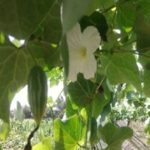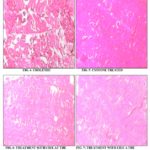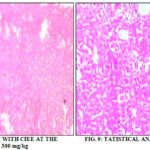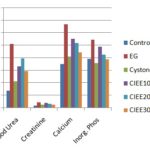IN-VIVO STUDY OF ANTILITHIATIC ACTIVITY ON THE FRUITS EXTRACTS OF COCCINIA INDICA (WIGHT & ARN.) ETHYLENE GLYCOL INDUCED LITHIATIC IN RATS
HTML Full TextIN-VIVO STUDY OF ANTILITHIATIC ACTIVITY ON THE FRUITS EXTRACTS OF COCCINIA INDICA (WIGHT & ARN.) ETHYLENE GLYCOL INDUCED LITHIATIC IN RATS
Mayank Kumar * 1, Shashi Alok 1, Sanjay Kumar Jain 1 and Amita Verma 2
Department of Pharmacognosy 1, Institute of Pharmacy Bundelkhand University, Jhansi - 284128, Uttar Pradesh, India.
Department of Pharmaceutical Sciences 2, SHIATS, Allahabad - 211007, Uttar Pradesh, India.
ABSTRACT: Aim of the Study: This study aimed to investigate the effect of ethanolic extract of fruits Coccinia indica Wight & Arn. (Cucurbitaceae) on urolithiasis in rats. Materials & methods: Thirty-six male rats were randomly divided into six groups (n = 6). Ethylene glycol (EG) 0.75% in drinking water were fed to all groups (Groups II-VI) except normal control (Group I) rats for 15-28th days to induce urolithiasis. Group III-VI rats were treated with ethanolic extract Coccinia indica of at doses 100, 200, 300 mg/kg, respectively, for 28 days. Positive control (Group II) rats were treated with EG alone. Group, I rats was administered drinking water and distilled water (6 μl/g) by gavage. After 15-28th days, blood samples were collected and analyzed for serum concentrations of calcium, Inorganic phosphorus, Blood urea, and creatinine. The kidneys were removed and sectioned for histopathological examination. The data were presented as mean ± standard error of the mean and analyzed using one-way analysis of variance P<0.05 was considered statistically significant. Results: In the present in-vivo study, renal stone inducing treatment to male rats resulted in hyperoxaluria. Ethanolic extract of Coccinia indica (at 100 and 200 mg/kg) exhibited a dose-dependent significant antilithiatic activity on treatment. The extract dose of 100 mg/kg also caused reduction of calcium, oxalates, phosphorus, and creatinine in blood serum level the results were found statistically significant. The antilithiatic effect of ethanol extract at was found effective than the reference standard. Histopathology of the kidneys in Groups V and VI revealed less tissue damage and were almost similar to Group I rats.
| Keywords: |
Coccinia indica, Antiurolithiatic, Ethylene glycol, Renal calculi, Nephrolithiasis
INTRODUCTION: The use of plants and plant products as medicines could be traced as far back as the beginning of human civilization. Medicinal plants are a source of great economic value all over the world. Nature has bestowed on us a very rich botanical wealth, and a large number of population and the major part of traditional therapy involves the use of plant extract and their active constituents.
Following the advent of modern medicine, herbal medicine suffered a setback, but during last two or three decades, advances in photochemistry and identification of plant compounds, effective against certain diseases have renewed the interest in herbal medicines 2.
Nowadays multiple drug resistance has developed due to the indiscriminate use of commercial antimicrobial drugs commonly used in the treatment of infectious disease. In addition to this problem, antibiotics are sometimes associated with adverse effects on the host including hypersensitivity, immune-suppression and allergic reactions 3. This situation forced to search for new antimicrobial substances.
Therefore, there is a need to develop alternative antimicrobial drugs for the treatment of infectious diseases from medicinal plants. Antimicrobials of plant origin have enormous therapeutic potential 4. They are effective in the treatment of infectious diseases while simultaneously mitigating many of the side effects that are often associated with synthetic antimicrobials 5. The beneficial medicinal effects of plant materials typically result from the combinations of secondary products present in the plant. In plants, these compounds are mostly secondary metabolites such as alkaloids, steroids, tannins, and phenol compounds, flavonoids, steroids, resin fatty acids gums which are capable of producing definite physiological action on the body 6. Coccinia indica belongs to the family Cucurbitaceae. It is growing wild throughout India and also cultivated in various parts of India. It is commonly known as kundru 7.
The whole plant is traditionally used for various medicinal purposes. Leaves of this plant are used in Indian folk medicine for treatment of the number of ailments including diabetes, wounds, ulcers, inflammation, in eruptions of skin, fever, asthma, and cough. Earlier scientific investigation of Coccinia indica showed that the crude extract has hepatoprotective 8, 9 10, 11, 12, 13, anti-diabetic hypolipidemic 14, 15, 16, 17, antibacterial 18, and anthelmintic activity 19, analgesic and antipyretic activity 20, wound healing activity 21, anti-inflammatory 22, 23 though the plant has been reported for many biological activities, no scientific data available to identify the genuine sample.
The present investigation was therefore taken up to establish the identity of fresh and dried fruits anti- urolithiasis activity for the standardization of the drug.
MATERIALS AND METHODS:
Collection and Authentification: The fresh fruits of wildly growing plant Coccinia indica were collected from the field areas of eastern Uttar Pradesh region during September 2012. For identification and taxonomic authentication, a sample of plant material was given to National Vrakshayurveda Research Institute (NVRI) Jhansi, India. The text report from National Vrakshayurveda research institute, Jhansi, India and confirmed the authenticity of plant material sample was Coccinia indica with voucher Specimen no. NVRI -SOP-20932, 01-09-2012. Collected plants were shade-dried and coarsely powdered. Fruits of Coccinia indica Wight & Arn. and authentication specimen record card gave respectively in Fig. 1 and Fig. 2.
FIG. 1: FRUITS OF COCCINIA INDICA WIGHT & ARN
FIG. 2: AUTHENTICATION OF SPECIMEN RECORD CARD
Extraction of Plant Materials: 250 g coarse powder of air-dried fruits of Coccinia indica were packed in a muslin cloth and subjected to Soxhlet extractor for continuous hot extraction with petroleum ether and ethanol for 8 hrs separately. Then each extract was filtered, and the filtrate was evaporated to dryness.
Preliminary Phytochemical Studies: Preliminary qualitative chemical investigations of ethanolic extract of Coccinia indica fruits were performed to know the presence of Carbohydrates, Glycosides, Alkaloids, Tannins, Flavonoids, triterpenoids. Further thin layer chromatography was performed to confirm their presence.
Chemical (Drugs & Solutions) and Apparatus: All the chemicals were analytical grade. Cystone was obtained from Himalaya Health Care Ltd. The ethanolic extract of plant Coccinia indica Wight & Arn. fruits were given with Tween 80 as vehicle administered orally. All chemicals were used of analytical grade available; Ethylene glycol was obtained from Merck Ltd., Mumbai, India.
Preparation of Dose: The dose of 100mg/kg, 200mg/kg, and 300mg/kg of ethanolic extract were selected for the test. All the doses were given orally after making a suspension in the vehicle, i.e. 1% Tween 80 and the standard drug, i.e. Cystone was given orally (750 mg/kg) in the vehicle.
Animal Selection: Male albino rats of Wistar strain weighing between 150-200 gm were selected for the antiurolithiatic activity. Animals were housed in polypropylene cages with the filter tops and maintained at 25 ± 2 ºC; relative humidity 55 ± 10% under controlled conditions of 12-h light: 12-h dark cycle. The animals were fed up with commercial rat chow and were given water ad libitum. All protocols of the study were approved by the Institutional Animal Ethical Committee with reference number BU/PHARM/IAEC/12/024. The committee approves the IAEC for control and supervision of experiments on animals (CPCSEA) with registration number 716/02/a/CPCSEA.
Acute Toxicity Studies:
Acute Oral Toxicity: The limit test of acute oral toxicity was carried out, and the relatively high LD50 value is determined by administering a dose of 50, 100, 150, 200, 400, 800, and 1000 mg/kg and mortality are observed after 24 h. The LD50 6 was determined graphically as describe earlier. It suggested that within this dose range is relatively safe and non-toxic to rats as no observable acute toxicity effect was produced.
Animal Groups: Thirty-six rats were divided into 6 groups comprising six animals per groups.
Group 1: Normal, ad libitum access to regular food and drinking water administered.
Group 2, 3, 4, 5 and 6, ad libitum access to regular food and ad libitum access to drinking water containing 0.75% (v/v) ethylene glycol (EG) to promote hyperoxaluria and CaOx deposition in the kidneys.
Group 2: Ethylene glycol 0.75% (v/v)
Group 3: Standard Drug (Cystone 750 mg/kg).
Group 4: Ethanolic extract of Coccinia indica fruits (100 mg/kg).
Group 5: Ethanolic extract of Coccinia indica fruits (200 mg/kg).
Group 6: Ethanolic extract of Coccinia indica fruits (300 mg/kg).
Design of Work: The rats were house in cages and divided into 6 groups of six animals each. Group 1 served as control and received regular rat food and drinking water ad libitum. Ethylene glycol (0.75%) in drinking water was fed to group 2 to 6 for induction of renal calculi till the 28th day. Group 2 receive only Ethylene glycol 0.75% (v/v), Group 3 received the standard antilithiatic drug, cystone (750mg/kg) from 15th day till 28th day. Group 4 to 6 received as a curative regimen, group 4 received ethanolic extract 100 mg/kg, group 5 received ethanolic extract 200 mg/kg, and group 6 received ethanolic extract 300 mg/kg from 15th day till 28th day.
Assessment of Antiurolithiatic Activity:
Serum Analysis: The blood was collected from the retro-orbital sinus under anesthetic condition, and serum was separated by centrifugation at 10,000 g for 10 min and analyzed for creatinine and uric acid. The creatinine kit (Reckon Diagnostics Pvt. Ltd., India) and uric acid diagnostic kit (Span Diagnostics Ltd., India) were used to estimate serum creatinine and uric acid levels respectively. Table 1 given serum biochemical data.
Kidney Histopathology and Homogenate Analysis: The abdomen was cut open to remove both kidneys from each animal. Isolated kidneys were cleaned off extraneous tissue and rinsed in ice-cold physiological saline. The right kidney was fixed in 10% neutral buffered formalin, processed in a series of graded alcohol and xylene, embedded in paraffin wax, sectioned at 5 ml and stained with H and E (Haematoxylin and Eosin) for histopathological examination. The slides were examined under a light microscope to study light microscopic architecture of the kidney and calcium oxalate deposits. The left kidney was finely minced, and 20% homogenate was prepared in Tris-HCl buffer (0.02 mol/l, pH 7.4). Fig. 4, 5, 6, 7, 8 and 9 of the kidney histopathology given below.
The Kidney Histopathology Vehicle Control:
The results were expressed as mean ± standard error mean (SEM). The statistical significance was assessed using one-way analysis of variance (ANOVA) followed by Dunnett’s comparison test and p < 0.05 was considered significant.
FIG. 3: ANTILITHIATIC ACTIVITY OF COCCINIA INDICA N= 6, VALUES ARE EXPRESSED AS MEAN ± SEM P<0.05 WHEN COMPARED WITH CONTROL GROUP
TABLE 1: GIVEN SERUM BIOCHEMICAL DATA
| Parameter
Unit (mg/dl) |
Group 1 Control | Group 2
(EG) |
Group 3 Cystone | Curative regimen (CIEE) | ||
| Group 4
100 mg |
Group 5
200 mg |
Group 6
300 mg |
||||
| Blood Urea | 2.73 ± 0.40 | 10.24 ± 0.22 | 4.27 ± 0.34 | 6.69 ± 0.27 | 7.90 ± 0.33 | 5.91 ± 0.22 |
| Creatinine | 0.39 ± 0.02 | 0.92 ± 0.03 | 0.49 ± 0.03 | 0.79 ± 0.02 | 0.68 ± 0.04 | 0.51 ± 0.02 |
| Calcium | 7.02 ± 0.4 | 13.42 ± 0.22 | 8.25 ± 0.31 | 11.04 ± 0.13 | 10.42 ± 0.22 | 8.92 ± 0.22 |
| Inorg. Phos | 7.82 ± 0.07 | 10.93 ± 0.24 | 7.17 ± 41 | 9.82 ± 0.23 | 8.49 ± 0.17 | 7.79 ± 0.22 |
Values are expressed as mean ± SEM, n=6 as compared to group 1 and 2, P<0.05 as compared to control group, determined by ANOVA
RESULTS: In the present in-vivo study, renal stone inducing treatment to male albino rats resulted in hyperoxaluria. There was an increased oxalate, calcium, phosphate, creatinine and uric acid excretion. However, supplementation with CIEE significantly prevented these changes in urinary oxalate, calcium, phosphate, creatinine and uric acid excretion dose-dependently.
Ethanolic extract of Coccinia indica Wight & Arn. fruits were subjected to antilithiatic activity in rats where Ethylene Glycol (0.75% (v/v) used as the causing lithiasis agent. A marked rise in calcium, oxalates, phosphorus, and creatinine in blood serum level observed in lithiasis control compared to normal control rats. Ethanolic extract of Coccinia indica (at 100 and 200 mg/kg) exhibited a dose-dependent significant antilithiatic activity on treatment. The extract dose of 100 mg/kg also caused reduction of calcium, oxalates, phosphorus and creatinine in blood serum level the results were found statistically significant. The antilithiatic effect of ethanol extract at was found statistically effective than the reference standard.
DISCUSSION: The present work was to carry out with the objective of ethanolic extract of fruits Coccinia indica Wight & Arn., phytochemical investigation, evaluation of the antilithiatic activity (in-vivo) against ethylene glycol induced lithiasis model. As the oral route usually takes traditional medicines, the same route of administration was used for evaluation of the protective effect of the CIEE against ethylene glycol induced urolithiasis in rats. Male rats were selected to induce urolithiasis because the urinary system of male rats resembles that of humans and earlier studies have shown that the amount of stone deposition in female rats was significantly less.
The biochemical mechanism for this process is related to an increase in the urinary concentration of oxalate. Stone formation in ethylene glycol fed is caused by hyperoxaluria, which causes increased renal retention and excretion of oxalate renal calcium oxalate deposition by EG (ethylene glycol) in rats is frequently used to mimic the urinary stone formation in humans. Therefore, this model was used to evaluate the protective effect of fruits Coccinia indica Wight & Arn. against urolithiasis. Normal urine contains many inorganic and organic inhibitors of crystallization; magnesium is one such well-known inhibitors. Low levels of magnesium are also encountered in stone formers as well as in stone-forming rats.
The magnesium levels return to normal on drug treatment diets high in magnesium have been found to protect against deposition of calcium oxalate in the kidneys of vitamin B6 deficient rats. Promising results in preventing recurrence have been shown in patients treated with potassium magnesium citrate. Magnesium complexes with oxalate and reduce the supersaturation of calcium oxalate by reducing the saturation of calcium oxalate and as a consequence reduces the growth and nucleation rate of calcium oxalate crystals. Urinary magnesium was significantly diminished in ethylene glycol induced urolithic rats.
The increase in urinary uric acid excretion was observed in urolithic rats. Increased excretion of uric acid has been reported in stone formers and hyperoxaluric rats. Uric acid interferes with calcium oxalate solubility, and it binds and reduces the inhibitory activity of glycosaminoglycans the predominance of uric acid crystals in calcium oxalate stones and the observation that uric acid binding proteins are capable of binding to calcium oxalate and modulate its crystallization also suggests its primary role in stone formation. Treatment of CIEE lowered the excretion of uric acid and reduces the risk of stone formation.
The present observation showed increased protein excretion in ethylene glycol induced urolithic rats. Proteinuria reflects proximal tubular dysfunction. Supersaturation of urinary colloids results in precipitation as crystal initiation particle which when trapped acts as a nidus leading to subsequent crystal growth. This is associated with proteinuria
Administration of CIEE had profound effects on minimizing the excretion of protein and thus might have prevented the nidus formation for crystal nucleation. The result showed the nephroprotective effect of fruits Coccinia indica Wight & Arn. in ethylene glycol induced urolithiasis model. An earlier study reported a high hypoglycemic and anti-inflammatory capacity of fruits Coccinia indica Wight & Arn. Therefore, CIEE may prevent calcium oxalate crystal deposition in the kidney by preventing hyperoxaluria-induced peroxidative damage to the renal tubular membrane surface (lipid peroxidation), which in turn can prevent calcium oxalate crystal attachment and subsequent development of kidney stones.
CONCLUSION: It can be concluded that the present study on C. indica fruits can serve as an important source of information to the reduction in oxalate excretion was observed on CIEE treatment. This decreased excretion of oxalate may be due to the inhibition of the formation of oxalate by the plant extract. The extract dose of 100 mg/kg also caused a partial reduction of calcium, oxalates, phosphorus, and creatinine in blood serum level the results were found statistically significant. The antilithiatic effect of ethanol extract at was found effective than the reference standard. Fruits of Coccinia indica Wight & Arn. better antilithiatic activity but it shows mild to moderate antilithiatic activity against ethylene glycol induced model.
ACKNOWLEDGEMENT: We are grateful to Mr. Shashi Alok, Assistant Professor, and Dr. Sanjay Kumar Jain, Reader Faculty of Pharmacy, Bundelkhand University, Jhansi for his assistance and encouragement. We extend our sincere thanks to Mr. Shashi Alok Assistant Professor, Faculty of Pharmacy, Bundelkhand University, Jhansi, for critically reading the manuscript and providing the valuable suggestions.
CONFLICT OF INTEREST: Nil
REFERENCES:
- Ahmed L, Mohammed Z and Mohammed F: Screening of some Indian medicinal plants for their antimicrobial properties. J Ethnopharmacol 1998; 62: 183-193;
- Arora D and Kaur J: Antimicrobial activity of spices. International J Antimicrobial Agents 1999; 12: 257-262.
- Gupta C, Amar P, Ramesh G, Uniyal C and Kumari A: Antimicrobial activity of some herbal oils against common food-borne pathogens. African J Microbiol Res 2008; 2: 258-261.
- Werner F, Okemo P and Ansorg R: Antibacterial activity of East African Medicinal plants. J Ethnopharmacol 1999; 60: 79-84.
- Perumalsamy R and Ignacimuthu S: Antibacterial activity of some folklore medicinal plants used by tribals in Western Ghats of India. J Ethnopharmacol 2000; 69: 63-71.
- Bishnu J, Sunil L and Anuja S: Antibacterial property of different medicinal plants Ocimum sanctum, Cinnamomum zeylanicum, Xanthoxylum armatum and Origanum majorana Kathmandu University. J Sci Engineering and Technol 2009; 5: 143-150.
- Wasantwisut E and TharaV: Ivy Gourd (Coccinia grandis Voigt, Coccinia cordifolia, Coccinia indica) in Human Nutrition and Traditional Applications, Plants in Human Health and Nutrition World Reviews of Nutrition and Dietetics, Basel, Karger 2003; 91: 60-66.
- Vadivu R, Krithika A, Biplab C, Dedeepya SP and Lakshmi KS: Evaluation of hepatoprotective activity of the fruits of Coccinia grandis International J Health Res 2008; 3: 63-168.
- Mohana GMR, Vijayakumar M, RaoCh V, Rawat AKS and Mehrotra S: Hepatoprotective effect of Coccinia indica against CCl4 induced Hepatotoxicity. Natural Product Sciences 2003; 1: 13-17.
- Shyam BK, Gnanasekaran D, Jaishree V and Channabasavaraj KP: Hepatoprotective activity of Coccinia indica leaves extract. Int J Pharm Biomed Res 2010; 4: 154-156.
- Ushasri B, Kiranmai M and Ibrahim M: Evaluation of Coccinia indica Mucilage as suspending agent in paracetamol. International journal of Drug Formulation and Research 2011; 6: 237-247.
- Maheswari C, Babu P and Meenakshi: Protective effect of Coccinia indica leaf extract against alcohol combined with carbon tetra chloride and paracetamol-induced liver damage in rats. International Journal of Pharmaceutical Sciences and Research 2011; 10: 2660-2664.
- Shivaji PG and Chandrasekhar MVR: Antihepatotoxic activities of Ci Compound ß Sitosterol isolated from fruits and leaves of Coccinia indica. Indian Journal of Pharmaceutical Education and Research 2012; 1: 4- 8.
- Shakya VK: Antidiabetic activity of Coccinia indica in streptozotocin-induced diabetic rats. Asian Journal of Chemistry 2008; 8: 6479-6482.
- Mallick C, Mandal S, Barik BB and Ghosh D: Protection of testicular dysfunctions by MTEC. A formulated herbal drug, in streptozotocin induced diabetic rat. Biological & Pharmaceutical Bulletin 2007; 1: 84-90.
- Manish G, Goutam KJ, Jha AK and Umashanker M: Pharmacognostic antihyperglycemic study of Coccinia indica. International Journal of Phytomedicine 2010; 2: 36-40.
- Versha P, Akanksha S, Ishan D and Deepak K: Combined effect of Coccinia indica (Wight & Arn) and Salvadora oleoides (Decne) on blood glucose level and other risk factors associated with Type-2 diabetes mellitus in alloxan-induced diabetic. International Journal of Pharmacy and Pharmaceutical Sciences 2012; 4: 79-84.
- Arshad H, Shadma W, Iffat Z and Sarfaraj HMD: Antibacterial activity of the leaves of Coccinia indica (W. and A) W of India. Advances in Biological Research 2010; 5: 241-248.
- Yogesh S, Prashant S, Priya S, Sonal D and Sourabh SB: Evaluation of anthelmintic activity of Coccinia indica (fruits). J Chem Pharm Res 2011; 1: 488- 491.
- Niazi J, Singh P, Bansal Y and Goel RK: Anti-inflammatory, analgesic and antipyretic activity of aqueous extract of fresh leaves of Coccinia indica. Inflammopharmacology 2009; 4: 239-44.
- Bambal VC, Wyawahare NS, Turaska AO and Deshmukh TA: Evaluation of Wound healing activity of herbal gel containing the fruit extracts of Coccinia indica Wight & Arn. (Cucurbitaceae). International Journal of Pharmacy and Pharmaceutical Sciences 2011; 4: 319-324.
- Sumana C and Aritra C: Proximate analysis, phytochemical screening and anti-inflammatory activity of Coccinia indica. International Journal of Pharmaceutical, Chemical and Biological Science 2012; 3: 299-304.
- Vaishali CB, Nitin SW, Sandip PC, Tushar AD and Vijay RP: Phytochemical investigation and anti-inflammatory activity of Coccinia indica Wight and Arn. (Cucurbitaceae) Fruits. Lat Am J Pharm 2010; 5: 820- 4.
How to cite this article:
Kumar M, Alok S, Jain SK and Verma A: In-vivo study of antilithiatic activity on the fruits extracts of Coccinia indica (wight & arn.) Ethylene glycol induced lithiatic in rats. Int J Pharmacognosy 2014; 1(1): 51-58. doi: 10.13040/IJPSR.0975-8232.1(1).51-58.
This Journal licensed under a Creative Commons Attribution-Non-commercial-Share Alike 3.0 Unported License.
Article Information
6
51-58
596
2397
English
IJP
M. Kumar *, S. Alok, S. K. Jain and A. Verma
Department of Pharmacognosy, Institute of Pharmacy Bundelkhand University, Jhansi, Uttar Pradesh, India.
mayank.pharma89@gmail.com
17 October 2013
24 November 2013
15 December 2013
http://dx.doi.org/10.13040/IJPSR.0975-8232.1(1).51-58
01 January 2014








